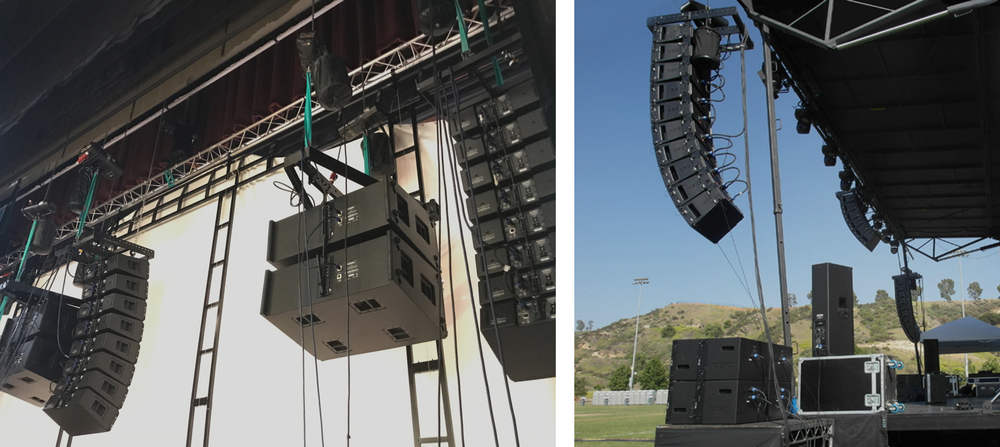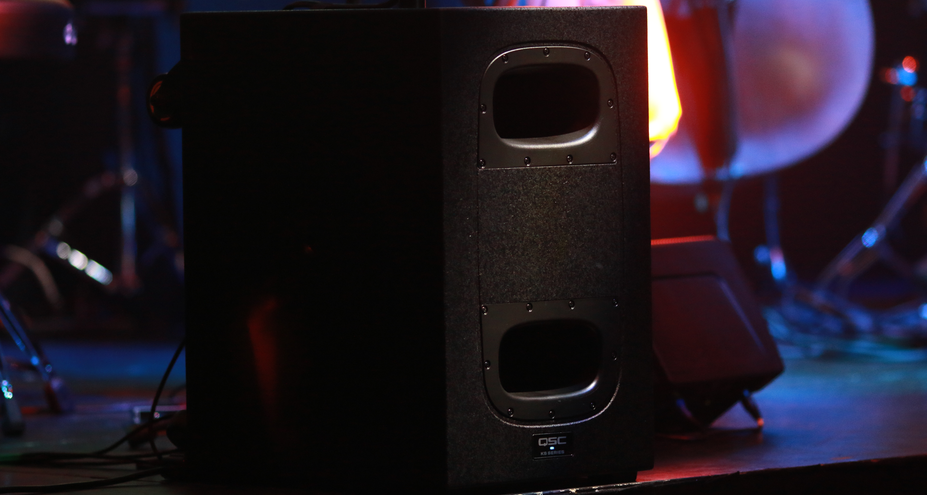When line-array loudspeaker systems are deployed in large venues, one issue that is most often debated is how to install subwoofers to adequately cover the entire audience. Should you keep the energy on the floor and deliver that tactile sense of bass to the crowd with a ground-stacked solution? Should you aim for more volume control with a flown subwoofer array? Or should you perhaps look to do both to really lay on the low end?
As previously discussed, subwoofer placement is a critical parameter affecting the entire sound system and its audio reproduction qualities (read further here on Comment placer correctement un caisson de graves dans une pièce). In front of the stage, under the stage, flown with left/right line array loudspeakers, flown in the middle, many variations are possible and, as with most things, there advantages and disadvantages to both floor-mounted and flown subwoofers. Let’s investigate further.
Consistent LF Sound Pressure
First, we need to state that consistency of sound pressure level (SPL) across the venue is the most important goal when setting up a PA system, subwoofers included. As with high and mid frequencies, low frequency sound coverage should be consistent from one side of the room to the other and from front to back with minimal fall-off in volume anywhere in the venue.
Acoustically this ‘fall-off’ is defined by the Inverse Square law, which states that the intensity of sound decreases by approximately 6 dB for each doubling of distance from the sound source. If that is a given, let’s also recall another aspect, variable this time; the room acoustics. At low frequency the acoustic of a venue (which includes standing waves, room modes, decay times, reflections, reverberation time, etc) is a critical and determining parameter affecting almost 50 percent of our overall subjective, in-room sound perception. The complete PA system, subwoofers included, contribute to the other 50 percent.
Different Radiation Spaces
Radiation space is defined by the space in which a loudspeaker is radiating sound into, and for a subwoofer these two typical spaces are, a full sphere, or a hemisphere. In a controlled acoustic environment (measuring chamber) it is rather simple to demonstrate that a subwoofer placed on the ground, which radiates sound in an hemispherical space will be twice as efficient (6 dB higher SPL), than the same unit flown, which would radiate omni-directionally.
In the real world, room modes and the inherent room standing waves affect considerably the effective subwoofers’ output and therefore the theoretical gain of 6 dB for floor-mounted subwoofers is often reduced to as much as only 3 dB. This is a difference in efficiency we must keep in mind.
Cluster, or Not
Additionally, the interaction between omnidirectional sound sources (subwoofers) and the room is always more complex (and therefore hard to control) when there are more than one source. This is true not only for live sound but also in studio control rooms or in home theater applications, for example. Multiple combinations of soundwaves traveling in all directions create a complex radiation model with more chances to generate a multitude of pressure minima and maxima across the room or the venue. This is why many sound engineers favor using a single cluster of floor-mounted or flown subwoofers, usually centrally mounted. However, this solution brings other practical disadvantages that we will also debate.
The Cardioid Solution
Before discussing pros and cons of actual subwoofer placements, let’s recall that for both floor-mounted or flown subwoofer deployments, the need to focus low frequency energy to the audience area and minimize the energy that could cause stage resonances or feedback with instruments on stage is key in many venues and applications.
Since the late 50’s sound engineers have successfully setup subwoofer’s array using a minimum of two units, and with careful adjustments of delay, polarity, output levels and distance between the units, they managed to force the radiated energy to become somewhat directional. So, the term cardioid radiation (or heart-shaped) refers to the shape of the directional coverage in which levels are louder at the front of the unit and quieter behind it. Cardioid subwoofer deployments can certainly benefit myriad live sound applications (read further to learn How to correctly position multiple Subwoofers for Cardioid Deployment).

Audible Pros and Cons of Flown versus Floor-Mounting
Note that all assessments below are always relative and highly dependent on the venue type, and its acoustics. Being able to identify what are the most important parameters (and deciding factors) for a specific venue or performance always comes first. So, let’s take a look at some audible pros and cons of flown subwoofers as opposed to floor-mounted options.
Pros. First,it is possible to achieve better volume control over the entire venue with flown subwoofers, as the distance difference between the subwoofers and the front row, and the subwoofers and the back row is reduced. Too high low frequency levels for the front rows might not be adequate for many types of music and audiences, which favor a more even coverage.
Secondly, more accurate delay timing can be dialed-in if subwoofers are flown closer to the main line array loudspeakers. Perfect time alignment can never be achieved for every seat in the venue, but flying subwoofers next to the main loudspeakers benefits the time delay greatly, when opposed to floor-mounted subwoofers. With a floor deployment, the front rows may be within a few meters/feet of the subwoofers, while being many meters/feet away from the main system. At the same time, the back row audience may have a nearly identical distance between the subwoofers and the main loudspeakers. With this configuration, time delay can become a lesser of two evils, and a time delay true to every seat cannot be obtained.
Cons. The half-space radiation loading from the floor is absent so that flown subwoofers radiate in an hemispherical space, leading to a volume loss – as explained above – compared to floor-mounted solutions. In addition, flown subwoofers are usually farther from the audience as opposed to when they are floor-mounted. These two factors combined present a first disadvantage.
Secondly, the first reflection from the energy bouncing off the floor surface combined with the on-axis sound radiation will create destructive interferences in various places in the venue. While the majority of venue floors are highly reflective at low frequencies, the importance of these LF cancellations is also highly related to the height of the subwoofers firing above the venue floor.
Thirdly, one of the most noticeable disadvantage is that as flown subwoofers are farther from the audience, some of the attack and ‘punch’ can also be felt as less impactful. However, while some of the punch may have gone, flown subwoofers do provide more even volume coverage of the audience area, as stated earlier.
Flown, Floored or Both
Often the result – and the right deployment strategy – is going to be a compromise between the optimal acoustic solution and all the other variables involved, such as weight, rigging points, cost/budgets, sightlines, trim height, time, SPL requirements, coverage and facility use.
And sometimes, the best way to achieve even coverage and impactful low end at the same time is to use both flown and floor-mounted subwoofers within the same PA system, benefiting from the best of both worlds. In the end there is no right or wrong answer – it all depends.
Practical Concerns
Note that many factors in subwoofer deployments have little to do with sound, and instead involve logistical and practical concerns. Here is a list of the most important ones:
Sightlines
Floor-mounted subwoofers will never block anyone’s view of the stage or the screen and are easier to hide, if needed. If flown subwoofers in a central cluster may be the ideal acoustical solution, they may compromise too much the sightlines and therefore warrant a compromised deployment solution.
Ceiling Loading
Loudspeakers are heavy, and flown subwoofers add to the load on the building roof or scaffolding structure. Ceilings can also experience mechanical resonances from certain building materials such as metal beams or ducts that floors would not.
Access, Repair and Replacement
Unless flown subwoofers are suspended using a winch system, access can be inconvenient and even expensive (renting a lift to service a fixed PA system). If remote control systems will allow you to easily adjust a variety of loudspeakers’ parameters and even receive telemetry data, they will not repair or replace drivers from the ground. Floor mounted subwoofers are definitely unbeatable in terms of serviceability.
Stage Coupling and Low-Frequency Feedback
Because floor-mounted subwoofers are usually positioned close to (or even under) the stage, they can cause low-frequency feedback or resonance problems, even with judicious use of high-pass filters. Flown subwoofers are far less likely to couple with the stage structure and cause feedback.
Ease of Installation
Floor-mounted subwoofers have the advantage of being easy to move to investigate different configurations. Spaced, clustered, straight-line or arched deployments are all fairly easy to accomplish. Not so much with flown subwoofers, due to the complexities of their installation and limited placement options.
Less Gear
Although it does not benefit the back of the venue as much as the front, the efficiency provided by floor-mounted subwoofers (half-space radiation) can be a great advantage in getting more output from fewer subwoofers, when budgets or physical space are tight.
Available Space
Where space near the stage is at a premium, flown subwoofers offer an obvious advantage. Moving subwoofers away from the ground to a flown position could free up spaces for a stage expansion or an extra row of seats.
Conclusion
The truth is that there is no right or wrong answer to the question of flown versus floor-mounted subwoofer deployments. It very much depends on the venue and on the type of performance. The sound engineer – or system installer – must decide first what are the most critical parameters that will dictate the choice of deployment. I hope that the insights described in this article will allow you to draw an educated choice the next time you will have to do so. Happy bass listening!
Christophe Anet
Derniers articles parChristophe Anet (voir tous)
- History, Development and Applications of Column Loudspeakers - May 30, 2025
- Why is Dynamic Range so important? - May 30, 2023
- Differences between Flown and Floor-Mounted Subwoofer Deployments - May 2, 2023
